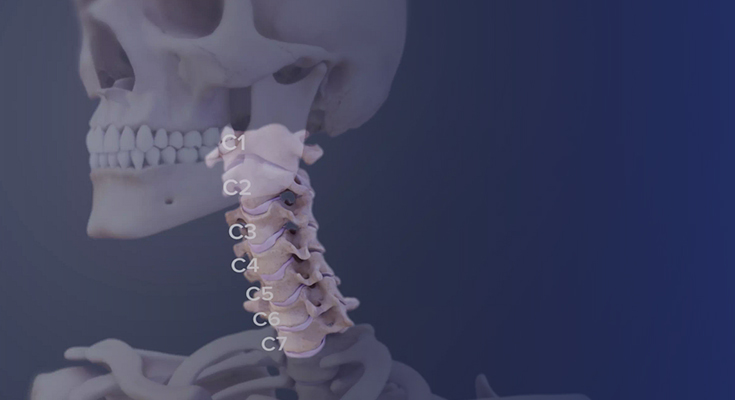Today we will discuss most of the information related to C2 and C5 spinal motion segments. And what the problems and complication can happen in these two segments and what are the best treatments for C2-C5 spinal motion segments.
Three Segments of C2-C5 Spinal Motion Segments:
- C2-C3
- C3-C4
- C4-C5
These three segments of C2-C5 spinal motion starts with C2 vertebra close to the upper side of the cervical spine. And these three segments of C2-C5 end in the midway of the mid-cervical spine at C5 vertebra.
When you move your neck backwards or forward the C2-C5 motion segments play a vital role in the mid-range of motions. On the other side, C4-C5 segments are more mobile compared to C2-C5.
When it comes to injury, C5-C7 (lower cervical spine) get injured more often than C2-C5 spinal motion segments. However, C2-C5 motion segments are also likely to get injured because of degeneration that may lead to problems like trauma, disc herniation, and neurological injury.
C2-C5 Motion Segments Structures:
First, we will start with the C2-C5 joints and vertebrae. The vertebrae in the C2-C5 segments are connected with paired facet joints and ligaments. These paired faced joints run downwards at the back of the spine and they help in the smooth gliding movements between adjacent vertebrae.
Intervertebral discs:
These discs are made up of a thick fibrous outer ring, also known as the annulus fibrosis. This thick substance has a gel-like core. These discs are placed between each vertebral.
These discs prevent vertebrae from grinding against each other, while you do any neck movement because of the shock-absorbing functions and cushioning.
Spinal Nerves:
There are small bony opening on the right and left side of your spinal canal called the intervertebral foramina; this is the place where spinal nerves exit within each motion segment.
Where these spinal nerves are located?
C3 – This spinal nerve dermatome mainly found over the parts of the upper neck area. The C3 spinal nerve includes some neck muscles that help you to bend your neck in the forward direction.
C4 – This spinal nerve dermatome found over the parts of skin over the shoulder area. The C4 myotome contains some muscles that help you to move your shoulders.
C5 – This spinal nerve dermatome found over the parts of skin over the shoulder area, forearm and upper arm. The C5 myotome contains some muscles that can help in shoulder movements.
Common issues in the C2-C5 motion segments:
Mainly C2—C5 motion segments/ vertebrae are prone to disease and injuries.
- Disc herniation.
- Spondylosis.
- Fracture.
- Congenital stenosis.
- Phrenic nerve damage.
- In some rare cases, infections and tumours can affect C2-C5 segments.
Common Symptoms of C2-C5 motion segments are:
- You might feel pain in the upper arm, neck and shoulder area the pain can be mild to severe. The pain can increase during the neck and arm movement, it may also flow from the upper neck to the back of your head, also known as cervicogenic headache.
- You may feel numbness in more than one part, like fingers, forearms and hands.
- You may feel weakness in the elbow, shoulder and wrist.
- You may also find it difficult to breathe properly and, this might happen due to the damage of the phrenic nerve.
Cervical radiculopathy:
This happens due to the compression in the C2-C5 spinal motion segments. This leads to loss of bowel or bladder control (not in all cases) weakness, pain and paralysis in the legs or arms.
Here are some nonsurgical treatments for C2-C5:
- Physical therapy.
- Pain-relieving medication.
- Injection procedures.
- Cervical traction.
- Steroid injections.
- Radiofrequency Ablation.
Other non-surgical treatments for pain management are:
- Transcutaneous electrical nerve stimulation (TENS).
- Acupuncture.
- Cognitive-behavioural therapy.
- Biofeedback is also a part of the C2-C5 treatment program.
What are the general techniques performed in the C2-C5 spinal motion segments?
Surgery happens to replace the part of the disc-like anterior cervical discectomy and fusion with ADR – cervical artificial disc replacement.
With the help of surgery, the medical experts try to reduce the radicular pain, relieve the pressure on the compressed nerve root and to reduce the disc pain.
Then, some surgeries are done to remove the part of a vertebra and bone spurs (a portion of overgrown bone), this helps to relieve the pressure on the compressed nerve.
The medical experts might also suggest someone or more procedure based on the severity of the injury and its location. In most of the cases, the patient after the surgery feels relieved from their symptoms within a period of a week.
The risk of some allergic reaction, excessive bleeding and infection are some of the serious complication one may face, but it is not common.

